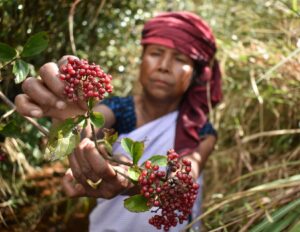On the 14th of June 2022, the Chief Minister of Meghalaya, Conrad K Sangma launched the Statewide Payment for Ecosystem Services (PES) Scheme. Recently the guidelines for the Scheme were finalized elaborating on the eligibility criteria for joining, amount of financial support that will be received by the beneficiaries (group or individual), timeline of support, and most importantly the various restrictions on the usage of land under the Scheme. With this Meghalaya has become the first to implement the Scheme in the entire North East. The ultimate rationale of the Scheme, as given in the ‘Frequently Asked Questions’ is “to reduce dependency on natural forests so that they can be conserved for many years into the future”. An analysis of the various provisions under the Scheme, however, gives the impression that while formulating it, there has been no consideration of the existing landscape management system which exists in the community, especially regarding forests. This is very critical as it could determine the success or failure of an initiative which has the potential to put Meghalaya on the path to Sustainable Development and achieve the various SDG Goals.
Dependence on forest, the prime focus of the Scheme, is very critical for indigenous peoples (including those of Meghalaya) whether it is for food, water, medicine, wood, biofuel, etc. These are known as Provisioning Services under the concept of Ecosystem Services on which the scheme is based. At the same time indigenous peoples are also well aware of the Regulating Services, i.e., importance of forest for maintaining ecological balance. This has been clearly brought out in the ‘The White/Wiphala Paper on Indigenous Peoples’ food systems’ published by Food and Agricultural Organisation of the UN which reported that although indigenous peoples occupy about 25 percent of the earth’s surface, their territories and lands have preserved 80 percent of the remaining terrestrial biodiversity. Indeed all the four biodiversity hotspots found in the Indian subcontinent, viz., Western Ghats and Sri Lanka, Indo-Burma, Himalaya and the Sundaland (which includes Andaman and Nicobar Islands) are home to many indigenous peoples including those of Meghalaya. This coincides with these groups having inhabited these regions for thousands of years, which include the Khasis of Meghalaya.
The paper ‘Two thousand years of iron smelting in the Khasi Hills, Meghalaya, North East India’ by Pawel Prokop and Ireneusz Suliga revealed that iron smelting, an important industry for the Khasis during the pre-colonial period, has been practiced in these hills for at least 2000 years. According to the authors, the manufacturing technology appears to be of indigenous origin which means that it was developed by the Khasis on their own. This must have taken a lot of time pushing the date of the first arrival of the Khasis in the region much earlier than 2000 years, maybe 3000-4000 years ago. But despite having inhabited the region for such a long period, the community has been able to protect and preserve a great deal of biodiversity achieving the Supporting Services as well. How was this achieved?
The essential feature of landscape management among the Khasis is the division of the landscape (which includes the forest) into different categories. These are then managed under rules which include traditional rules continuing from the past and new rules formulated in recent times. The rules, in turn, regulate access and usage keeping in mind the sustainability of the resource base. Law Adong or restricted forest is the best example of this system. Sometimes being synonymous with Khlaw Shnong (village forest), but at other times an entirely separate category in itself, access to Law Adong is not restricted but the type of usage is strictly controlled. The uses permitted, in fact, match those listed under the permissible activities in the Scheme’s guidelines, i.e., firewood, medicinal plants and herbs, fruits, mushrooms, honey and other produce save one. But felling of trees especially for timber is listed among prohibited activities. It is mentioned again in the permissible activities but as a prohibition “collection of minor forest produce for household use … that is not timber.”
Traditional rules governing the Law Adong also prohibit the cutting of trees for timber. This however is not a permanent moratorium which the scheme proposes. In emergency situations (e.g., funerals, house getting burned down) or when someone in the village is in dire need of support, felling of trees is allowed. Proceeds from the sales then goes to the Dorbar Shnong which can use the fund for helping the needy in the village. Removal of trees from the Law Adong is also allowed for the purpose of rejuvenating the forest. This was one of the most important insights shared during the participatory workshop organized by NESFAS in the village of Ladmawphlang (located in the Khatarshnong Laitkroh Block) on the 29th of July, 2022. During the discussion on forest management, the local community explained that removal of old trees was an age-old practice for ensuring the health of the forest. The same is, in fact, a very well-established forestry method being practiced throughout the world, another example of conventional science validating a traditional indigenous practice. Removal of trees can have other ecological benefits as well.
A 2017 story published in Science, world’s leading interdisciplinary journal titled ‘To save forests, cut some trees down, scientists say’ found that thinning woodlands could actually help trees fight climate change, while conserving scarce resources. When trees get too crowded, the competition for light and water is too high leading to stressed trees becoming more susceptible to drought and insect attacks. Thinning eases the competition, and it leads to the remaining trees growing big and healthy. But most importantly it did not have a negative impact on forest carbon storage. The total carbon was found to be nearly the same in both thinned and unthinned forest: the un-thinned forest had more trees, but the thinned forest compensated with bigger trees. By prohibiting any felling of trees for at least the next 30 years, the Scheme has ignored the socio-economic and ecological benefits of traditional forest management practiced by the indigenous peoples of Meghalaya.
Another provision which reveals the lack of consultation with the local indigenous peoples on the ground is the inclusion of jhum (shifting cultivation) in the list of prohibited activities under the Scheme. This is a continuation of an adversary mindset ignoring the observations made in the 2018 NITI Ayog, ‘Report of Working Group III Shifting Cultivation: Towards a Transformational Approach’. The report has stated that jhum is a distinct land use which combines both agriculture and forest management shifting the debate from jhum destroying forests to actually being very valuable to ecosystem services because of its landscape management approach. Also since the majority of the farmers in the State are small and marginal farmers (cultivating less than 2 ha of land) 8000 rupees per hectare is highly inadequate to compensate for the loss of food security and income, something again which the Report warned has happened where jhum was replaced by other systems. Worse, in other parts of the world, such schemes have resulted in indigenous peoples losing their rights to ancestral land and territories while at the same time being criminalized for carrying out sustenance activities within their own territories.
The PES Scheme is a very laudable initiative. But it will be a mistake to project the principles and rationale behind it as something alien to the indigenous peoples of Meghalaya. This appears to have happened when the guidelines are prepared especially about the permissible and prohibited activities. Consultation with the local indigenous peoples and appreciation of local traditional knowledge should always be considered in the guidelines of any scheme or funding agencies for development initiatives. The Scheme instead should be about rewarding the indigenous peoples of Meghalaya for protecting the natural resources for thousands of years and strengthening the landscape management system which made that possible. Erosion of traditional values and entry of market forces has no doubt increased the pressure on the indigenous landscape management system leading to degradation and deterioration of the environment. This Scheme can help in combating that but in its current form will not be able to do that. It might in fact make it worse.
This article was originally published in the Highland Post



